胡塞尔现象学阅读法_励志
胡塞尔现象学的方法

胡塞尔现象学的方法哎呀,说起胡塞尔现象学的方法,那可真是有意思得很呢!胡塞尔啊,就像是一个超级侦探,在努力探寻着意识的奥秘。
他提出的那个“悬搁”,就好比是让我们把那些先入为主的观念啦、偏见啦都统统放到一边去,就像把挡在眼前的树叶拨开,才能看清后面的风景呀。
你想想看,要是我们一直被那些乱七八糟的想法缠着,怎么能真正看清事物的本质呢?还有那个“本质直观”,这可真是神奇嘞!就好像我们有一双特别的眼睛,可以直接看到事物最核心的部分。
不用去分析、推理那么复杂,就是直接去感受、去领悟。
这多有趣呀,就好像我们突然有了一种超能力,可以一下子抓住最关键的东西。
比如说,我们看到一朵花,平常可能就是觉得它好看或者不好看。
但用胡塞尔的方法呢,我们要去深入体会这朵花带给我们的各种感受,它的颜色、形状、香气,以及看到它时我们内心的那种触动。
这可不是简单地看看而已哦,这是要用心去感受的嘞!再比如,我们和别人交流的时候,不要只听对方说的话表面的意思,要去体会他话语背后的那种情绪、意图。
这就像是在挖掘宝藏一样,一层一层地深入下去,找到最珍贵的东西。
胡塞尔现象学的方法就像是给我们打开了一扇全新的大门,让我们看到了一个不一样的世界。
它让我们更加关注自己的内心体验,更加敏锐地去感知周围的一切。
你说,这是不是很奇妙呢?它不是那种死板的理论,而是可以让我们在生活中随时随地运用的方法呀。
当我们学会了用这种方法去看待世界,很多以前我们忽略的细节就会一下子冒出来,让我们惊叹不已。
我们平时总是忙忙碌碌,很少有时间静下心来好好去感受、去思考。
但胡塞尔现象学告诉我们,这样可不行哦!我们要学会停下来,去关注那些被我们遗忘的美好。
想想看,如果我们每个人都能运用胡塞尔的方法,那我们的世界会变得多么不一样啊!我们会更加理解彼此,更加珍惜生活中的点点滴滴。
所以啊,大家可别小瞧了这胡塞尔现象学的方法,它真的可以给我们带来很多意想不到的收获呢!。
胡塞尔现象学①
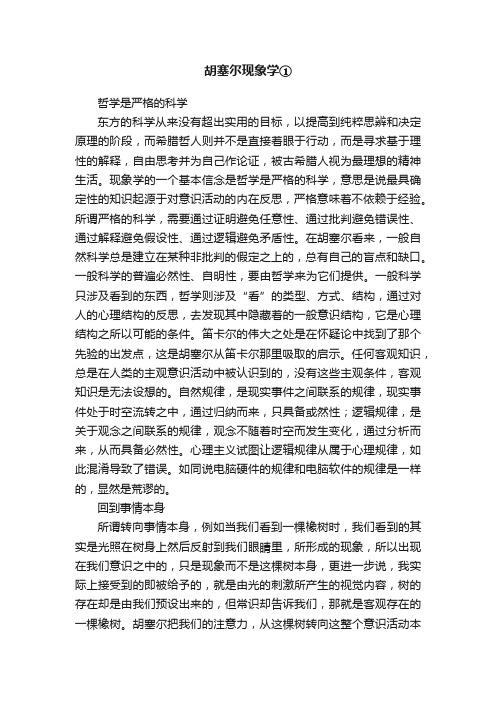
胡塞尔现象学①哲学是严格的科学东方的科学从来没有超出实用的目标,以提高到纯粹思辨和决定原理的阶段,而希腊哲人则并不是直接着眼于行动,而是寻求基于理性的解释,自由思考并为自己作论证,被古希腊人视为最理想的精神生活。
现象学的一个基本信念是哲学是严格的科学,意思是说最具确定性的知识起源于对意识活动的内在反思,严格意味着不依赖于经验。
所谓严格的科学,需要通过证明避免任意性、通过批判避免错误性、通过解释避免假设性、通过逻辑避免矛盾性。
在胡塞尔看来,一般自然科学总是建立在某种非批判的假定之上的,总有自己的盲点和缺口。
一般科学的普遍必然性、自明性,要由哲学来为它们提供。
一般科学只涉及看到的东西,哲学则涉及“看”的类型、方式、结构,通过对人的心理结构的反思,去发现其中隐藏着的一般意识结构,它是心理结构之所以可能的条件。
笛卡尔的伟大之处是在怀疑论中找到了那个先验的出发点,这是胡塞尔从笛卡尔那里吸取的启示。
任何客观知识,总是在人类的主观意识活动中被认识到的,没有这些主观条件,客观知识是无法设想的。
自然规律,是现实事件之间联系的规律,现实事件处于时空流转之中,通过归纳而来,只具备或然性;逻辑规律,是关于观念之间联系的规律,观念不随着时空而发生变化,通过分析而来,从而具备必然性。
心理主义试图让逻辑规律从属于心理规律,如此混淆导致了错误。
如同说电脑硬件的规律和电脑软件的规律是一样的,显然是荒谬的。
回到事情本身所谓转向事情本身,例如当我们看到一棵橡树时,我们看到的其实是光照在树身上然后反射到我们眼睛里,所形成的现象,所以出现在我们意识之中的,只是现象而不是这棵树本身,更进一步说,我实际上接受到的即被给予的,就是由光的刺激所产生的视觉内容,树的存在却是由我们预设出来的,但常识却告诉我们,那就是客观存在的一棵橡树。
胡塞尔把我们的注意力,从这棵树转向这整个意识活动本身,尽可能把所有形而上的预设(比如树的存在)悬置起来,通过考察这整个意识活动本身,来说明为什么我们会把光的刺激所引发的现象,看作是客观存在的一棵树。
现象学胡塞尔

布伦坦诺的价值哲学——“一件事情不是因为上帝命令它才是善的,而是因为它本身就是善的,上帝才命令它”现象学胡塞尔胡塞尔——海德格尔吸收现象学方法创立存在主义哲学——二战后期,流行存在主义——六十年代,解释学他的思想分四阶段:对数学和逻辑的研究创立现象学把现象学发展为先验唯心主义向生活世界的转化哲学负有崇高使命,以人类的永久性目标为己任。
现象学名词背后的要求:哲学应该搁置一切过于仓促的世界,毫无偏见地分析在意识中出现的现象。
胡塞尔的目标:借由现象学的方法建立一个作为“严格科学”的哲学。
经验科学是事实科学,无法达到此程度。
而数学作为一种推理逻辑,绝对严格,绝对无时间性的。
经验自然科学是一种“事实科学”。
原因在于:经验中获得的事实是在时间上被规定的东西。
经验科学不具有绝对的无可置疑性。
只能带来暂时的功利,不能提供造福于子孙万代的、超越其特殊的经验世界的知识。
什么是严格科学?科学是代表一种绝对的、无时间性的价值的称号。
严格科学的条件——必须是绝对正确的知识。
必须是无时间性、超时间的真理。
必须为子孙后代造福。
《逻辑研究》中,胡塞尔与当时流行的心理主义决裂。
心理主义宣称逻辑法则不外是心理性法则的表现,逻辑必须还原到心理基础上。
胡塞尔确证纯粹逻辑的理想性:它的法则独立于实际的思考行动里的具体内容之外。
胡塞尔反对科学主义和心理主义哲学要成为严格科学,必须与经验自然科学的事实科学划清界限,克服将哲学混同或归于事实科学旗下的科学主义。
心理主义将绝对的、无可置疑的逻辑规律,降低为以个人心理活动为转移的经验事实,这就陷入主观主义和相对主义。
建立科学哲学的关键:回到事物本身不要像“科学主义”和“人生观哲学那样”,不关心真正的“客观真理”。
回到事物本身的方法:摆脱一切未经考察的偏见和假设,直接面对“事物”本身。
“事物”并非客观存在的具体事物,而是泛指所有可能存在的对象,物质的或者精神的,存在的或不存在的。
现象学的特点:一旦哲学通过直觉描述到了意识到的现象,那就能描述意识活动的结构以及同这种意识活动相应的意识对象的本质结构。
胡塞尔的现象学
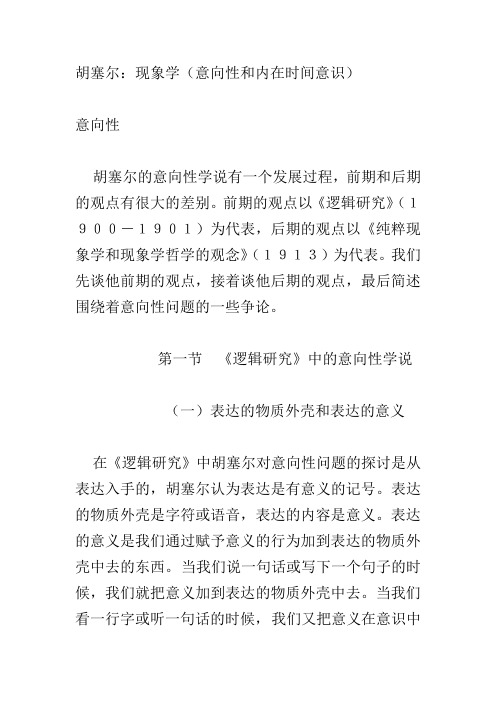
胡塞尔:现象学(意向性和内在时间意识)意向性胡塞尔的意向性学说有一个发展过程,前期和后期的观点有很大的差别。
前期的观点以《逻辑研究》(1900-1901)为代表,后期的观点以《纯粹现象学和现象学哲学的观念》(1913)为代表。
我们先谈他前期的观点,接着谈他后期的观点,最后简述围绕着意向性问题的一些争论。
第一节《逻辑研究》中的意向性学说(一)表达的物质外壳和表达的意义在《逻辑研究》中胡塞尔对意向性问题的探讨是从表达入手的,胡塞尔认为表达是有意义的记号。
表达的物质外壳是字符或语音,表达的内容是意义。
表达的意义是我们通过赋予意义的行为加到表达的物质外壳中去的东西。
当我们说一句话或写下一个句子的时候,我们就把意义加到表达的物质外壳中去。
当我们看一行字或听一句话的时候,我们又把意义在意识中再现出来。
离开了人的意义意向的行为,那么任何记号都不可能成为有意义的语言。
胡塞尔用一个例子来说明意向行为与记号的关系。
假如我们走到一个清真寺去,我们不懂阿拉伯文字,我们看到墙上用阿拉伯文字雕刻的可兰经的经文,我们把它们当成装饰性的图案。
胡塞尔问道:“例如让我们设想,某些圆圈和半圆的曲线条最初给我们一种纯粹的美的感觉,后来我们突然想到它们可能是字符或文字的记号。
其差别存在于什么地方呢?”1 他答道差别在于我们的意向行为不同。
开始时我们没有把这些线条与意义联结在一起,所以我们把它们当作引起美感的图案,后来我们想到这些线条表示意义,于是我们就把它们当作文字了。
(二)对象化的活动的三个环节胡塞尔认为,当我们表达一个意义的时候,我们的意识活动包括三个环节:a)意向行为,b)意义(意向内容),c)对象。
“每个表达不仅意味着什么,而且涉及到某种东西;它不仅有意义,而且与某个对象发生关系。
”2“表达通过意义表示(指称)对象。
”3在此对象可以是实在的对象,也可以是观念的对象、想象的对象。
把表达的意义(意向内容)与对象区分开来十分重要,这不仅因为;有时对象相同而意义不同,如“依恩纳的战胜者”和“滑铁卢的战败者”具有不同的意义,但同指一个对象,即那破仑。
胡塞尔现象学
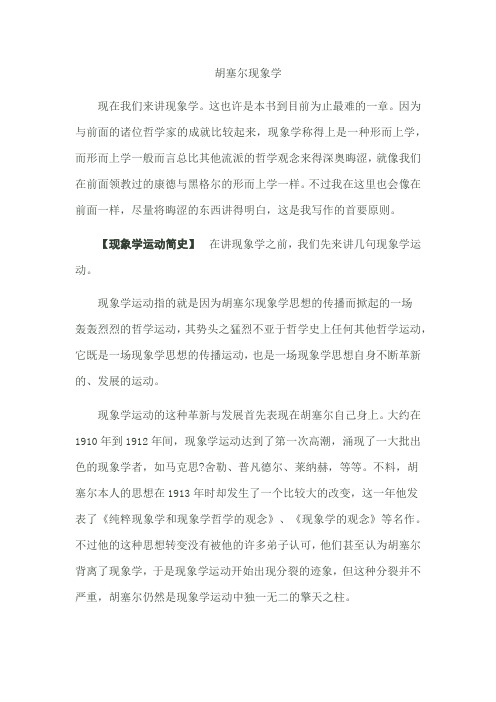
胡塞尔现象学现在我们来讲现象学。
这也许是本书到目前为止最难的一章。
因为与前面的诸位哲学家的成就比较起来,现象学称得上是一种形而上学,而形而上学一般而言总比其他流派的哲学观念来得深奥晦涩,就像我们在前面领教过的康德与黑格尔的形而上学一样。
不过我在这里也会像在前面一样,尽量将晦涩的东西讲得明白,这是我写作的首要原则。
【现象学运动简史】在讲现象学之前,我们先来讲几句现象学运动。
现象学运动指的就是因为胡塞尔现象学思想的传播而掀起的一场轰轰烈烈的哲学运动,其势头之猛烈不亚于哲学史上任何其他哲学运动,它既是一场现象学思想的传播运动,也是一场现象学思想自身不断革新的、发展的运动。
现象学运动的这种革新与发展首先表现在胡塞尔自己身上。
大约在1910年到1912年间,现象学运动达到了第一次高潮,涌现了一大批出色的现象学者,如马克思?舍勒、普凡德尔、莱纳赫,等等。
不料,胡塞尔本人的思想在1913年时却发生了一个比较大的改变,这一年他发表了《纯粹现象学和现象学哲学的观念》、《现象学的观念》等名作。
不过他的这种思想转变没有被他的许多弟子认可,他们甚至认为胡塞尔背离了现象学,于是现象学运动开始出现分裂的迹象,但这种分裂并不严重,胡塞尔仍然是现象学运动中独一无二的擎天之柱。
1916年,胡塞尔到达弗赖堡大学后,现象学运动的中心也移到了这里。
在胡塞尔周围很快又聚集了一批优秀的青年学者,涌现了现象学运动的第二批代表人物,如海德格尔、英伽登、伽达默尔、霍克海默尔、马尔库塞,等等,这些人的聚会使弗赖堡成为世界公认的哲学中心之一,堪与牛津、剑桥或者哈佛相匹。
但是,这第二批的精英中有许多人不久也与胡塞尔产生了观念上的分歧,特别是他的大弟子海德格尔。
海德格尔在1927年发表了《存在与时间》,这部巨著突破了胡塞尔的现象学思想,是现代西方哲学史上的奠基性著作之一,堪与胡塞尔的《逻辑研究》相比,胡塞尔的许多学生因此都拜服在海德格尔的思想之下,渐渐疏远了胡塞尔。
胡塞尔现象学方法浅析
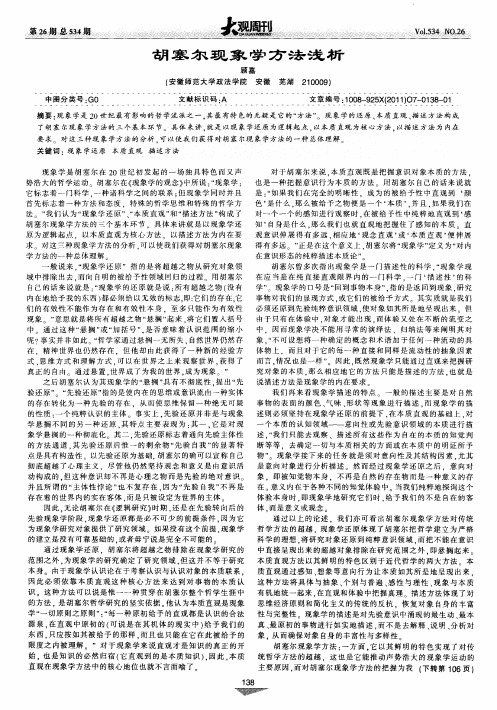
中 . 因而 现 象 学 决 不 能 用 寻 常 的演 绎 法 、归 纳 法 等 来 阐 明其 对
呢 7 实并 非 如 此 “ 学 家 通 过 悬搁 一 无 所 失 . 事 哲 自然 世 界仍 然存 象 .不 可设 想 将 一 种 确 定 的概 念 和 术 语 加 于 任 何 一 种 流动 的具 “ 在 .精 神世 界也 仍 然 存 在 .但 他 却 由此 获 得 了一 种 新 的经 验 方 体 物上 .而且 对 于它 的每 一 种 直 接 和 同 样 是 流 动 性 的抽 象 因 素 式 、 维 方 式 和理 解 方 式 . 以在 世 界 之 上 来 观 察 世 界 , 得 了 思 可 获 真 正 的 自由 通 过 悬 置 . 界 成 了 为我 的世 界 . 为 现 象 。” 世 成 验 还原 ” “ 验 还 原 ” 的 是 使 内在 的思 维 或 意识 流 南一 种 实 体 先 指 而 言 , 况 也是 一 样 ” 因此 . 情 。 既然 现 象 学 只 能 通 过直 观 来 把 握 研 究 对 象 的 本 质 . 么 相 应 地 它 的方 法 只 能 是 描 述 的 方 法 . 就 是 那 也 我 们 再 来看 现象 学 描 述 的 特 点 一 般 的 描 述 主 要 是 对 自然 事 物 的表 面 的 颜 色 、 味 、 状 等 现 象 进 行 描 述 . 现 象 学 的 描 气 形 而 述 则 必 须 坚 持 在 现 象 学 还 原 的 前 提 下 . 本 质 直 观 的基 础 上 . 在 对
一
之 后 胡 塞 尔 认 为其 现 象 学 的 “ 搁 ” 有 不 彻 底 性 . 出 “ 悬 具 提 先 说 描述 方 法 是 现 象 学 的 内在 要 求
胡塞尔著作阅读顺序

胡塞尔著作阅读顺序
如果你想要阅读胡塞尔的著作,以下是一个可能的阅读顺序:
1. 《现象学的观念》:这本书是胡塞尔现象学的入门书籍,介绍了现象学的基本观念和原则。
2. 《欧洲科学的危机与超越论的现象学》:这本书探讨了欧洲科学的危机和现象学的超越论方法。
3. 《第一哲学》(上下卷):这本书是胡塞尔的重要著作之一,包含了他对哲学史的研究和超越论哲学的论述。
4. 《内时间意识现象学》:这本书探讨了时间意识的现象学,是胡塞尔对于意识研究的重要贡献。
5. 《逻辑研究》(全三册):这本书是胡塞尔的代表作之一,系统地阐述了他的逻辑现象学思想。
6. 《共主观性的现象学》(全三卷):这本书探讨了共主观性问题,是胡塞尔对于现象学的进一步发展。
需要注意的是,胡塞尔的著作具有一定的难度和复杂性,建议你在阅读之前做好充分的准备工作,包括了解胡塞尔的思想背景和研究领域,以及阅读一些相关的导论和介绍性书籍。
此外,由于胡塞尔的著作数量较多,你可以根据自己的兴趣和研究需要选择适合自己的书籍进行阅读。
胡塞尔的现象学方法综论

胡塞尔的现象学方法综论以胡塞尔现象学思想的整个发展过程为背景,对其现象学的主要方法:本质还原与先验还原分别进行了详细论述,同时具体阐述了二者的关联和过渡。
本文在对胡塞尔整体思想把握的基础上,试图对其现象学的方法做一个简要的综述。
标签:本质直观;先验还原;悬搁;纯粹自我;意向性胡塞尔创立了现象学,他提出的现象学思想以及他运用的现象学方法,不仅为欧洲大陆20世纪最重要的哲学思潮——现象学运动的产生和发展提供了基础,而且作为一种方法,现象学对自然科学和社会科学领域的发展都产生了深刻的影响。
胡塞尔一生追求“严格科学的哲学”的信念,这样一种笛卡尔式的理想。
他说,“人类文化的最高兴趣要求一种严格科学的哲学的发展;因此,如果我们的时代中的哲学革命要有理由,它就务必是被为严格科学意义上的哲学设置基础这一目的所激发的。
”[1]他要求排除一切预先假设,使哲学成为一门明证性的、没有任何前提和假设的科学的哲学。
正是为了这一信仰,胡塞尔运用现象学的独特方法开辟了现象学领域。
本文主要参照倪梁康先生的《现象学及其效应——胡塞尔与当代德国哲学》及其主编的《胡塞尔选集》,拟就“本质直观”和”先验现象学还原”(简称“先验还原”)的方法做一简要的综述,并对现象学方法的这两个不同阶段的关联和过渡进行初步探究。
一、本质还原本质还原(eidetische Reduktion)是现象学用来排除经验事实,从而达到对本质的把握的一种方法。
胡塞尔的一生前、后期思想变化很大,但本质还原的方法(亦称范畴直观、本质直观、或观念直观),却是唯一一种贯穿在胡塞尔整个哲学生涯中的方法,从“描述心理学”的《逻辑研究》,到《纯粹现象学和现象学哲学的观念》,最后到《欧洲科学的危机与超验现象学》,本质直观(Wesensschau)的方法始终是胡塞尔哲学研究分析的坚实依据。
但我们还是不难看到,胡塞尔在其学术生涯的各个阶段对本质直观的理解的变化是很大的。
1.在《逻辑研究》阶段,胡塞尔就已经对近代哲学的传统做了突破。
现象学方法是一种

现象学方法是一种引言现象学方法是一种哲学上的研究方法,旨在通过对现象本身的直接观察和描述,以揭示现象背后的本质和意义。
它强调以客观、中立的方式描述和分析事物,排除主观偏见和预设观念的干扰。
本文将介绍现象学方法的起源、基本原理和应用,以及它在不同学科领域中的实践。
起源与发展现象学方法起源于德国哲学家爱德蒙·胡塞尔(Edmund Husserl)在20世纪初提出的现象学学派。
他认为传统的哲学研究方法太过关注概念和理论,忽视了直接经验和实际现象的重要性。
因此,他希望发展一种新的研究方法,以实事求是地探寻事物的本质和意义。
基本原理现象学方法的核心原理是“回归到事物本身”(back to the things themselves)。
它要求研究者摒弃先入为主的观念和假设,以客观、无预设的态度来观察和描述现象。
研究者需要通过直接感知和经验,从事物本身中发现它的真实形态和内在意义,而非根据理论或假设来解释现象。
应用领域现象学方法在许多领域中都有广泛的应用。
首先是哲学领域,特别是现象学学派,他们通过对现象进行直接描述和分析,研究意识、主体性和存在问题。
其次是社会学和人类学,现象学方法被用来研究人类群体的行为和经验,揭示社会结构和文化的本质。
此外,现象学方法还被应用于艺术、心理学、教育学等学科领域,帮助我们更好地理解和解释人类的创造性、情感和认知活动。
实践方法在实践中,现象学方法有一套明确的步骤和技巧。
首先是直觉的练习,研究者需要培养直接感官的能力,通过直观观察和描述现象,避免理论和假设的干扰。
其次是反思和回顾,研究者需要反思并回顾观察、描述的过程,检查个体主张和个体差异的存在。
最后是转述和再现,研究者需要将对现象的观察和描述精确地转述和再现,以便进一步的研究和讨论。
现象学方法的优势和局限性现象学方法的优势在于它能够提供直接的、客观的事实描述,避免主观偏见和预设观念的干扰。
它强调对现象本身的关注,能够揭示事物的本质和意义,为后续的理论建构提供了基础。
西方哲学史 第七讲 胡塞尔

(1)什么是意向性
❖ 德语中意向性一词来自拉丁文,意思是“指 向”或“对准”。
❖ 所谓意向性,简言之就是“意识行为有所指 向的特性”。与人相应,意向性行为就是具 有有所指向的特性的意识行为。这有所指向 的特性乃是人类意识的基本特征,指出人的 意识及其对象同时呈现,也是胡塞尔进行哲 学思考的起点。
❖ 胡塞尔自己所言:“意向性表现了意识的基 本性质……全部现象学问题都与之密切相 关”。意向性理论是胡塞尔对哲学的主要贡 献。
?1901年10月胡塞尔到哥廷根大学任副教授在那里虽然渐渐有了一批志同道合者但胡塞尔的学术生涯并不一帆风顺他申请教授曾被拒绝同事的贬低和自我怀疑一度使他对自己几乎失去信心但此时在他的影响下的已经有了哥廷根和慕尼黑两个现象学研究的圈子了
第七讲 现象学学派创始人—— 胡塞尔
一、现象学概论
❖ 现象学是现代西方哲学中影响很大,持续时间很长 的一个流派,与柏格森的生命哲学、祁克果的生存 哲学、弗洛依德的心理学等一起,极深刻地影响了 西方哲学的发展。它于20世纪初兴起于德国,然后 逐渐传播到世界各地,成为一个名副其实的哲学运 动。这个运动包括胡塞尔、海德格尔、舍勒、萨特、 利维纳斯、梅洛—庞蒂等许多重要的现代西方哲学 家。这些人的名字几乎就构成了半部现代西方哲学。
❖ 这时候,胡塞尔终于意识到了面临的危机:要 么通过毕业考试继续升学,要么回家跟父亲做 小生意去。胡塞尔醒悟了,开始奋发学习。他 竟然顺利通过了毕业会考,成绩还不错。据说 当校长向学监报告时,说这次成绩还不错的胡 塞尔“是我们学校最差的学生”。
❖ 1876年6月底,胡塞尔进入莱比锡大学。一开 始时,他主修天文学,喜欢数学、物理和哲学。
❖ 现象:事物在发展变化中所表现的外部 的形态和联系。(现象的本意是显现出 来的东西)
胡塞尔和他的现象学共24页文档

2、要冒一次险!整个生命就是一场冒险。走得最远的人,常是愿意 去做,并愿意去冒险的人。“稳妥”之船,从未能从岸边走远。-戴尔.卡耐基。
梦 境
3、人生就像一杯没有加糖的咖啡,喝起来是苦涩的,回味起来却有 久久不会退去的余香。
胡塞尔和他的现象学4、守业的最好办法就是不断的发展。 5、当爱不能完美,我宁愿选择无悔,不管来生多么美丽,我不愿失 去今生对你的记忆,我不求天长地久的美景,我只要生生世世的轮 回里大的骄傲于最大的自卑都表示心灵的最软弱无力。——斯宾诺莎 7、自知之明是最难得的知识。——西班牙 8、勇气通往天堂,怯懦通往地狱。——塞内加 9、有时候读书是一种巧妙地避开思考的方法。——赫尔普斯 10、阅读一切好书如同和过去最杰出的人谈话。——笛卡儿
现象学研究方法

现象学研究方法现象学是20世纪初德国哲学家胡塞尔创立的一种哲学方法,它强调对事物本身的直接观察和描述,而不受到理论假设或先入为主的观念的干扰。
在社会科学和人文学科领域,现象学研究方法被广泛运用,以深入理解人类行为、社会现象和文化现象。
本文将介绍现象学研究方法的基本原理和实践步骤。
首先,现象学研究方法强调对事物的直接观察和描述。
研究者需要以开放的心态去接触和理解研究对象,避免预设观念和假设的干扰。
在研究过程中,研究者应尽量避免对研究对象进行评判或解释,而是以客观的态度去观察和描述现象的本质特征和内在结构。
其次,现象学研究方法注重对研究对象的深入理解。
研究者需要通过对研究对象的直接观察和描述,逐渐揭示其内在的意义和价值。
在这个过程中,研究者需要运用丰富的描述性语言,将研究对象的各个方面进行详细而准确的描述,以便深入理解其本质和特征。
另外,现象学研究方法强调研究者的主观参与和情感体验。
研究者需要以亲身经历的方式去感受和理解研究对象,将自己的情感和体验融入到研究过程中。
通过主观参与和情感体验,研究者可以更加深入地理解研究对象的内在意义和特征,从而得出更加准确和深刻的研究结论。
最后,现象学研究方法强调研究者的反思和批判。
研究者需要对自己的观察和描述进行反思和批判,以确保其研究结果的客观性和准确性。
在研究过程中,研究者应不断审视自己的主观偏见和观念假设,以保持对研究对象的客观和准确的理解。
总之,现象学研究方法是一种重视对事物本身的直接观察和描述的哲学方法,它强调研究者的主观参与和情感体验,以及对研究对象的深入理解和反思批判。
通过运用现象学研究方法,研究者可以更加深入地理解和解释人类行为、社会现象和文化现象,为社会科学和人文学科的研究提供了重要的方法论基础。
胡塞尔现象学阅读法_学习方法
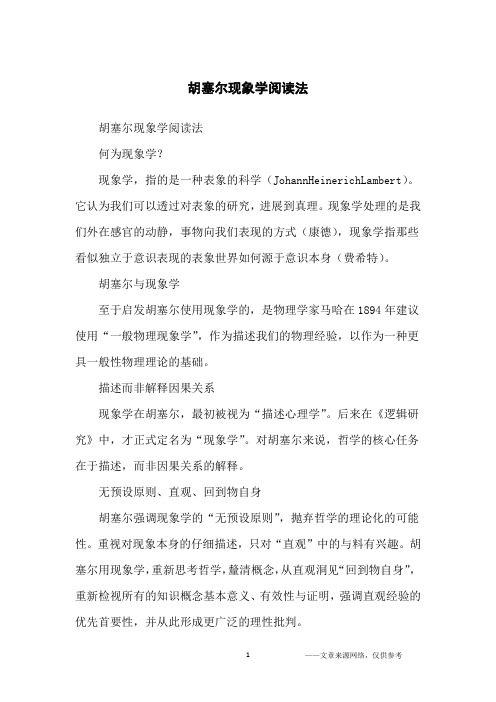
胡塞尔现象学阅读法胡塞尔现象学阅读法何为现象学?现象学,指的是一种表象的科学(JohannHeinerichLambert)。
它认为我们可以透过对表象的研究,进展到真理。
现象学处理的是我们外在感官的动静,事物向我们表现的方式(康德),现象学指那些看似独立于意识表现的表象世界如何源于意识本身(费希特)。
胡塞尔与现象学至于启发胡塞尔使用现象学的,是物理学家马哈在1894年建议使用“一般物理现象学”,作为描述我们的物理经验,以作为一种更具一般性物理理论的基础。
描述而非解释因果关系现象学在胡塞尔,最初被视为“描述心理学”。
后来在《逻辑研究》中,才正式定名为“现象学”。
对胡塞尔来说,哲学的核心任务在于描述,而非因果关系的解释。
无预设原则、直观、回到物自身胡塞尔强调现象学的“无预设原则”,抛弃哲学的理论化的可能性。
重视对现象本身的仔细描述,只对“直观”中的与料有兴趣。
胡塞尔用现象学,重新思考哲学,釐清概念,从直观洞见“回到物自身”,重新检视所有的知识概念基本意义、有效性与证明,强调直观经验的优先首要性,并从此形成更广泛的理性批判。
存而不论、自然搁置、超验还原胡塞尔对于扭曲与阻碍我们认识日常生活经验方式的意识结构与内容检查模式,提出了强烈的质疑。
胡塞尔则提出了对自然世界“存而不论”,“自然搁置”的“超越还原”,以便将衬托出现象的中心基本性质。
放入括弧胡塞尔把自然世界“放入括弧”里,要求我们把过去所有的一切都放在括弧里,放在一旁,不要让这些所产生的联想,影响到我们对于现象的观察,进而妄加推断。
我们必须拒绝所有原有的假设或前提,只单单接收现象所给我们呈现的东西,使先于判断的经验从而可能。
对于我们来说,过往的生活世界,无形中替我们形成了一个充满预设、想法、偏见、知识的领域。
我们所生活的生活世界,早已充满各种见解知识判断传统道德法律科学知识偏见,我们并不是直接的生活在生活世界里,从生活世界里直观并得出结果,而是生活在诸多的预设和前提下,透过建构的概念世界,建构我们所经验到的生活世界。
胡塞尔现象学(同济学报稿)
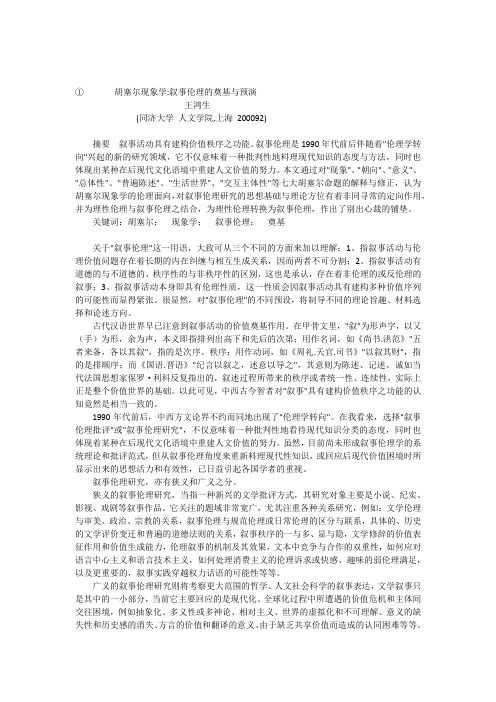
①胡塞尔现象学:叙事伦理的奠基与预演王鸿生(同济大学人文学院,上海200092)摘要叙事活动具有建构价值秩序之功能。
叙事伦理是1990年代前后伴随着"伦理学转向"兴起的新的研究领域,它不仅意味着一种批判性地料理现代知识的态度与方法,同时也体现出某种在后现代文化语境中重建人文价值的努力。
本文通过对"现象"、"朝向"、"意义"、"总体性"、"普遍陈述"、"生活世界"、"交互主体性"等七大胡塞尔命题的解释与修正,认为胡塞尔现象学的伦理面向,对叙事伦理研究的思想基础与理论方位有着非同寻常的定向作用,并为理性伦理与叙事伦理之结合,为理性伦理转换为叙事伦理,作出了别出心裁的铺垫。
关键词:胡塞尔;现象学;叙事伦理;奠基关于"叙事伦理"这一用语,大致可从三个不同的方面来加以理解:1、指叙事活动与伦理价值问题存在着长期的内在纠缠与相互生成关系,因而两者不可分割;2、指叙事活动有道德的与不道德的、秩序性的与非秩序性的区别,这也是承认,存在着非伦理的或反伦理的叙事;3、指叙事活动本身即具有伦理性质,这一性质会因叙事活动具有建构多种价值序列的可能性而显得紧张。
很显然,对"叙事伦理"的不同预设,将制导不同的理论旨趣、材料选择和论述方向。
古代汉语世界早已注意到叙事活动的价值奠基作用。
在甲骨文里,"叙"为形声字,以又(手)为形,余为声,本义即指排列出高下和先后的次第;用作名词,如《尚书.洪范》"五者来备,各以其叙",指的是次序、秩序;用作动词,如《周礼.天官.司书》"以叙其财",指的是排顺序;而《国语.晋语》"纪言以叙之,述意以导之",其意则为陈述、记述。
胡塞尔:现象学的应用

胡塞尔:现象学的应用胡塞尔提出现象学运动,目的是要找到一个方法,以便获得纯粹状态的现象。
因为现象总是被我们先入为主的成见给扭曲了,所以我们要回归现象本身。
现象是什么任何东西,不论是你想象的还是确实存在的,理想的或者现实的,并且不管以何种方式出现的,只要使它本身能够呈现在人的意识里面,就是现象。
简单的说,就是你意识里的东西就是现象。
现象学,是一种方法,就是要使人见到事物在自身,显露自己的方法,没有成见没有预设,呈现出本身的样子的方法。
这样一个原始的没有预设的学科,才可以成为别的学科的预设,这样哲学才能成为一门严格的科学。
两种还原现象学在应用的时候,有两种还原,本质的还原,现象学的还原。
本质的还原,就是把本质之外的东西,先放在一边存而不论。
比如自己的内心感受主观判断都放一边,只关注对象的本质。
这个本质包括人对对象可以描述的所有具体条件。
现象学的还原,更进一步,要把思想内容与意识无关的部分也放一边,也就是把,所见到的现象与外在世界的一切关系,也统统不管。
现象学把对象仅仅当作对象来看,至于这个对象是不是独立存在的某种东西,先不管。
经过两种还原,还剩下的,是纯粹的但不是空虚的意识,只剩下能知与所知。
能知就是能认识的,所知就是所认识的。
认识,只能在人的意识里发生,所以外在世界如何先不管,先要做到的是,让外在事物本身展现自己,呈现出现象。
一个循环除了两种还原,还有一个循环,认识的循环。
就是我们在认识一样东西的时候,一定已经具备了某种预先的了解,否则就根本不知道这是哪一类东西。
现象学里有个概念,地平线。
我站在旷野看去,所看到的边界就是地平线。
如果看到有个尖角,我不确定是个教堂,还是个犀牛角。
只有一个方法去弄清,就是慢慢走近,直到某一个点,就忽然清晰确定了。
认识,就是两个地平线的融合,或者叫视野的融合。
我听一个人讲话,从听不懂,经过他的解释到最后听懂了,代表我们两个人的视野就好像两个地平线有了交汇的地方。
自由想象法自由想象就是举各种例子,针对这个现象举出一些例子,这些例子同时具有说明和证明的双重作用。
胡塞尔现象学的方法
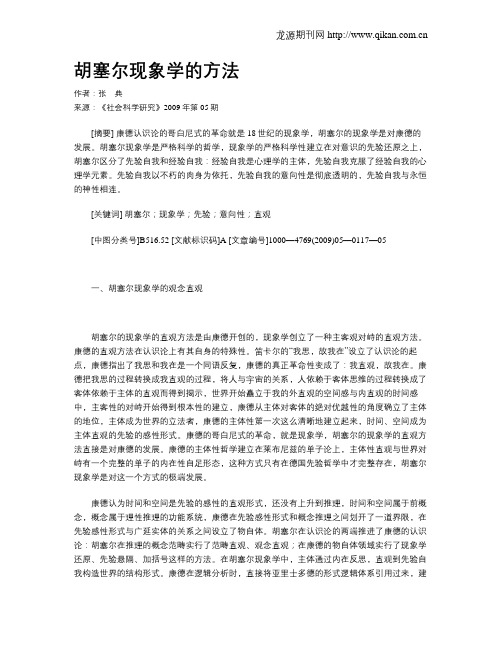
胡塞尔现象学的方法作者:张典来源:《社会科学研究》2009年第05期[摘要] 康德认识论的哥白尼式的革命就是18世纪的现象学,胡塞尔的现象学是对康德的发展。
胡塞尔现象学是严格科学的哲学,现象学的严格科学性建立在对意识的先验还原之上,胡塞尔区分了先验自我和经验自我:经验自我是心理学的主体,先验自我克服了经验自我的心理学元素。
先验自我以不朽的肉身为依托,先验自我的意向性是彻底透明的,先验自我与永恒的神性相连。
[关键词] 胡塞尔;现象学;先验;意向性;直观[中图分类号]B516.52 [文献标识码]A [文章编号]1000—4769(2009)05—0117—05一、胡塞尔现象学的观念直观胡塞尔的现象学的直观方法是由康德开创的,现象学创立了一种主客观对峙的直观方法。
康德的直观方法在认识论上有其自身的特殊性。
笛卡尔的“我思,故我在”设立了认识论的起点,康德指出了我思和我在是一个同语反复,康德的真正革命性变成了:我直观,故我在。
康德把我思的过程转换成我直观的过程,将人与宇宙的关系,人依赖于客体思维的过程转换成了客体依赖于主体的直观而得到揭示,世界开始矗立于我的外直观的空间感与内直观的时间感中,主客性的对峙开始得到根本性的建立,康德从主体对客体的绝对优越性的角度确立了主体的地位,主体成为世界的立法者,康德的主体性第一次这么清晰地建立起来,时间、空间成为主体直观的先验的感性形式。
康德的哥白尼式的革命,就是现象学,胡塞尔的现象学的直观方法直接是对康德的发展。
康德的主体性哲学建立在莱布尼兹的单子论上,主体性直观与世界对峙有一个完整的单子的内在性自足形态,这种方式只有在德国先验哲学中才完整存在,胡塞尔现象学是对这一个方式的极端发展。
康德认为时间和空间是先验的感性的直观形式,还没有上升到推理,时间和空间属于前概念,概念属于理性推理的功能系统,康德在先验感性形式和概念推理之间划开了一道界限,在先验感性形式与广延实体的关系之间设立了物自体。
胡塞尔为大英百科全书撰写的“现象学”条目
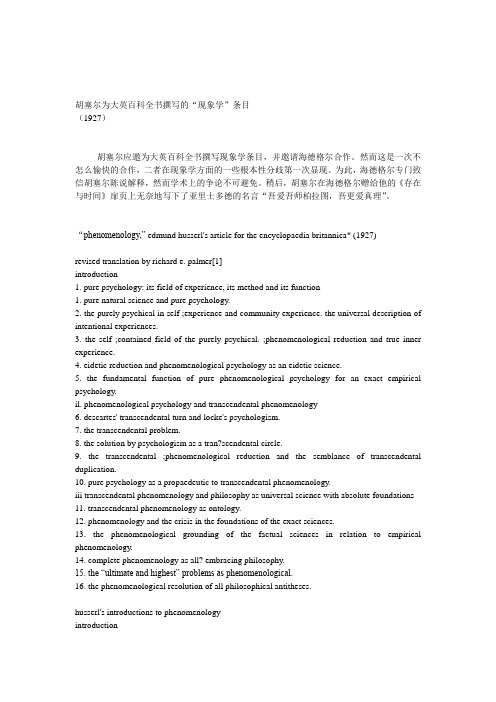
胡塞尔为大英百科全书撰写的“现象学”条目(1927)________________________________________胡塞尔应邀为大英百科全书撰写现象学条目,并邀请海德格尔合作。
然而这是一次不怎么愉快的合作,二者在现象学方面的一些根本性分歧第一次显现。
为此,海德格尔专门致信胡塞尔陈说解释,然而学术上的争论不可避免。
稍后,胡塞尔在海德格尔赠给他的《存在与时间》扉页上无奈地写下了亚里士多德的名言“吾爱吾师柏拉图,吾更爱真理”。
“phenomenology,” edmund husserl's article for the encyclopaedia britannica* (1927)revised translation by richard e. palmer[1]introduction1. pure psychology: its field of experience, its method and its function1. pure natural science and pure psychology.2. the purely psychical in self ;experience and community experience. the universal description of intentional experiences.3. the self ;contained field of the purely psychical. ;phenomenological reduction and true inner experience.4. eidetic reduction and phenomenological psychology as an eidetic science.5. the fundamental function of pure phenomenological psychology for an exact empirical psychology.il. phenomenological psychology and transcendental phenomenology6. descartes' transcendental turn and locke's psychologism.7. the transcendental problem.8. the solution by psychologism as a tran?scendental circle.9. the transcendental ;phenomenological reduction and the semblance of transcendental duplication.10. pure psychology as a propaedeutic to transcendental phenomenology.iii transcendental phenomenology and philosophy as universal science with absolute foundations11. transcendental phenomenology as ontology.12. phenomenology and the crisis in the foundations of the exact sciences.13. the phenomenological grounding of the factual sciences in relation to empirical phenomenology.14. complete phenomenology as all? embracing philosophy.15. the “ultimate and highest” problems as phenomenological.16. the phenomenological resolution of all philosophical antitheses.husserl's introductions to phenomenologyintroductionthe term 'phenomenology' designates two things: a new kind of descriptive method which made a breakthrough in phi?losophy at the turn of the century, and an a priori science derived from it; a science which is intended to supply the basic instru?ment (organon) for a rigorously scientific philosophy and, in its consequent applica?tion, to make possible a methodical reform of all the sciences. together with this philo-sophical phenomenology, but not yet sepa?rated from it, however, there also came into being a new psychological discipline parallel to it in method and content: the a priori pure or “phenomenological” psychology, which raises the reformational claim to be?ing the basic methodological foundation on which alone a scientifically rigorous empiri?cal psychology can be established. an out?line of this psychological phenomenology, standing nearer to our natural thinking, is well suited to serve as a preliminary step that will lead up to an understanding of philo?sophical phenomenology.i. pure psychology: its field of experience, its method, and its function1. pure natural science and pure psychology.modern psychology is the science dealing with the “psychical” in the concrete context of spatio ;temporal realities, being in some way so to speak what occurs in nature as ego?ical, with all that inseparably belongs to it as psychic processes like experiencing, think?ing, feeling, willing, as capacity, and as habitus. experience presents the psychical as merely a stratum of human and animal be?ing. accordingly, psychology is seen as a branch of the more concrete science of an?thropology, or rather zoology. animal reali?ties are first of all, at a basic level, physical realities. as such, they belong in the closed nexus of relationships in physical nature, in nature meant in the primary and most preg?nant sense as the universal theme of a pure natural science; that is to say, an objective science of nature which in deliberate one ;sidedness excludes all extra ;physical predi?cations of reality. the scientific investiga?tion of the bodies of animals fits within this area. by contrast, however, if the psychic as?pect of the animal world is to become the topic of investigation, the first thing we have to ask is how far, in parallel with the pure sci?ence of nature, a pure psychology is possible. obviously, purely psychological research can be done to a certain extent. to it we owe the basic concepts of the psychical according to the properties essential and specific to it. these concepts must be incorporated into the others, into the psychophysical founda?tional concepts of psychology.it is by no means clear from the very out?set, however, how far the idea of a pure psychology ;-as a psychological discipline sharply separate in itself and as a real paral?lel to the pure physical science of nature has a meaning that is legitimate and neces?sary of realization.2. the purely psychical in self ;experience and community experience. the universal description of intentional experiences.to establish and unfold this guiding idea, the first thing that is necessary is a clar-ification of what is peculiar to experience, and especially to the pure experience of the psychical ;and specifically the purely psy?chical that experience reveals, which is to become the theme of a pure psychology. it is natural and appropriate that precedence will be accorded to the most immediate types of experience, which in each case reveal to us our own psychic being.focusing our experiencing gaze on our own psychic life necessarily takes place as re?flection, as a turning about of a glance which had previously been directed else-where. every experience can be subject to such reflection, as can indeed every manner in which we occupy ourselves with any real or ideal objects ;for instance, thinking, or in the modes of feeling and will, valuing and striving. so when we are fully engaged in conscious activity, we focus exclusively on the specific thing, thoughts, values, goals, or means involved, but not on the psychical experience as such, in which these things are [23] known as such. only reflection reveals this to us. through reflection, instead of grasping simply the matter straight-out--the values, goals, and instrumentalities--we grasp the corresponding subjective experiences in which we become “conscious” of them, in which (in the broadest sense) they “appear.” for this reason, they are called “phenomena,” and their most general essential character is to exist as the “consciousness-of” or “appearance-of” the specific things, thoughts (judged states of affairs, grounds, conclusions), plans, decisions, hopes, and so forth. this relatedness [of the appearing to the object of appearance] resides in the meaning of all expressions in the vernacular languages which relate to psychic experience --for instance, perception o/something, recalling of something, thinking of something, hoping/or something, fearing something, striving for something, deciding on something, and so on. if this realm of what we call “phenomena” proves to be the possible field for a pure psychological discipline related exclusively to phenomena, we can understand the designation of it as phenomenological psychology. the terminological expression, deriving from scholasticism, for designating the basic character of being as consciousness, as consciousness of something, is intentionality. in unreflective holding of some object or other in consciousness, we are turned or directed to-wards it: our “intentio” goes out towards it. the phenomenological reversal of our gaze shows that this “being directed” [gerichtet-sein] is really an immanent essential feature of the respective experiences involved; they are “intentional” experiences.an extremely large and variegated number of kinds of special cases fall within the general scope of this concept. consciousness of something is not an empty holding of something; every phenomenon has its own total form of intention [intentionale gesamtform], but at the same time it has a structure, which in intentional analysis leads always again to components which are themselves also intentional. so for example in starting from a perception of something (for example, a die), phenomenological reflection leads to a multiple and yet synthetically unified intentionality. there are continually varying differences in the modes of appearing of objects, which are caused by the changing of “orientation”-of right and left, nearness and farness, with the consequent differences in perspective involved. there are further differences in appearance between the “actually seen front” and the “unseeable” [“unanschaulichen”] and relatively “undetermined” reverse side, which is nevertheless “meant along with it.” observing the flux of modes of app earing and the manner of their “synthesis,” one finds that every phase and portion [of the flux] is already in itself “consciousness-of '-but in such a manner that there is formed within the constant emerging of new phases the synthetically unified awareness that this is one and the same object. the intentional structure of any process of perception has its fixed essential type [seine feste wesenstypik], which must necessarily be realized in all its extraordinary complexity just in order for a physical body simply to be perceived as such. if this same thing is intuited in other modes-for example, in the modes of recollection, fantasy or pictorial representation- to some extent the whole intentional content of the perception comes back, but all aspects peculiarlytransformed to correspond to that mode. this applies similarly for every other category of psychic process: the judging, valuing, striving consciousness is not an empty having knowledge of the specific judgments, values, goals, and means. rather, these constitute themselves, with fixed essential forms corresponding to each process, in a flowing intentionality. for psychology, the universal task presents itself: to investigate systematically the elementary intentionalities, and from out of these [unfold] the typical forms of intentional processes, their possible variants, their syntheses to new forms, their structural composition, and from this advance towards a descriptive knowledge of the totality of mental process, towards a comprehensive type of a life of the psyche [gesamttyplts eines lebens der seele]. clearly, the consistent carrying out of this task will produce knowledge which will have validity far beyond the psychologist's own particular psychic existence.psychic life is accessible to us not only through self-experience but also through [24] experience of others. this novel source of ex?perience offers us not only what matches our self ;experience but also what is new, inas?much as, in terms of consciousness and in?deed as experience, it establishes the differ?ences between own and other, as well as the properties peculiar to the life of a commu?nity. at just this point there arises the task of also making phenomenologically under?standable the mental life of the community, with all the intentionalities that pertain to it.3. the self ;contained field of the purely psychical. --phenomenological reduction and true inner experience.the idea of a phenomenological psychol?ogy encompasses the whole range of tasks arising out of the experience of self and the experience of the other founded on it. but it is not yet clear whether phenomenological experience, followed through in exclusive?ness and consistency, really provides us with a kind of closed ;off field of being, out of which a science can grow which is exclusively focused on it and completely free of every?thing psychophysical. here [in fact] difficul?ties do exist, which have hidden from psy?chologists the possibility of such a purely phenomenological psychology even after brentano's discovery of intentionality. they are relevant already to the construction of a really pure self ;experience, and therewith of a really pure psychic datum. a particular method of access is required for the pure phenomenological field: the method of ”phe?nomenological reduction.“ this method of `phenomenological reduction” is thus the foundational method of pure psychology and the presupposition of all its specifically theoretical methods. ultimately the great difficulty rests on the way that already the self ;experience of the psychologist is every?where intertwined with external experience, with that of extra ;psychical real things. the experienced “exterior” does not belong to one's intentional interiority, although cer?tainly the experience itself belongs to it as experience ;of the exterior. exactly this same thing is true of every kind of awareness directed at something out there in the world. a consistent epoche of the phenomenologist is required, if he wishes to break through to his own consciousness as pure phenomenon or as the totality of his purely mental pro?cesses. that is to say, in the accomplishment of phenomenological reflection he must in?hibit every co ;accomplishment of objective positing produced in unreflective conscious?ness, and therewith [inhibit] every judg?mental drawing ;in of the world as it “exists” for him straightforwardly. the specific expe?rience of this house, this body, of a world as such, is and remains, however, according to its own essential content and thus insepara?bly, experie nce “of this house,” this body, this world; thisis so for every mode of con?sciousness which is directed towards an object. it is, after all, quite impossible to de?scribe an intentional experience ;even if il?lusionary, an invalid judgment, or the like ;without at the same time describing the object of that consciousness as such. the universal epoche of the world as it becomes known in consciousness (the “putting it in brackets”) shuts out from the phenomeno-logical field the world as it exists for the sub?ject in simple absoluteness; its place, how?ever, is taken by the world as given in con?sciousness (perceived, remembered, judged, thought, valued, etc.) ;the world as such, the “world in brackets,” or in other words, the world, or rather individual things in the world as absolute, are replaced by the re?spective meaning of each in consciousness [bewusstseinssinn] in its various modes (per?ceptual meaning, recollected meaning, and so on).with this, we have clarified and supple?mented our initial determination of the phenomenological experience and its sphere of being. in going back from the unities pos?ited in the natural attitude to the manifold of modes of consciousness in which they ap?pear, the unities, as inseparable from these multiplicities ;b ut as “bracketed” ;are also to be reckoned among what is purely psychi?cal, and always specifically in the appearance?-character in which they present themselves. the method of phenomenological reduc?tion (to the pure “phenomenon,” the purely psychical) ac cordingly consists (1) in the me?thodical and rigorously consistent epoche of every objective positing in the psychic sphere, both of the individual phenomenon and of the whole psychic field in general; [25] and (2) in the methodically practiced seizing an d describing of the multiple “appearances” as appearances of their objective units and these units as units of component meanings accruing to them each time in their appearances. with this is shown a two-fold direction--the noetic and noematic of phenomenological description. phenomenological experience in the methodical form of the phenomenological reduction is the only genuine “inner experience” in the sense meant by any well-grounded science of psychology. in its own nature lies manifest the possibility of being carried out continuously in infinitum with methodical preservation of purity. the reductive method is transferred from self-experience to the experience of others insofar as there can be applied to the envisaged [vergegen-w?rtigten] mental life of the other the corresponding bracketing and description according to the subjective “how” of its appearance and what is appearing (“noesis” and “noema”). as a further consequence, the community that is experienced in community experience is reduced not only to the mentally particularized intentional fields but also to the unity of the community life that connects them all together, the community mental life in its phenomenological purity (intersubjective reduction). thus results the perfect expansion of the genuine psychological concept of “inner experience.”to every mind there belongs not only the unity of its multiple intentional life-process [intentionalen lebens] with all its inseparable unities of sense directed towards the “object.” there is also, inseparable from this life-process, the experiencing i-subject as the identical i-pole giving a centre for all specific intentionalities, and as the carrier of all habitualities growing out of this life-process. likewise, then, the reduced inter-subjectivity, in pure form and concretely grasped, is a community of pure “persons” acting in the intersubjective realm of the pure life of consciousness.4. eidetic reduction and phenomenological psychology as an eidetic science.to what extent does the unity of the field of phenomenological experience assure the possibility of a psychology exclusively based on it, thus a pure phenomenological psychology? it does not automatically assure an empirically pure science of facts from which everything psychophysical is abstracted. but this situation is quite different with an a priori science. in it, every self-enclosed field of possible experience permits eo ipso the all embracing transition from the factual to the essential form, the eidos. so here, too. if the phenomenological actual fact as such becomes irrelevant; if, rather, it serves only as an example and as the foundation for a free but intuitive variation of the factual mind and communities of minds into the a priori possible (thinkable) ones; and if now the theoretical eye directs itself to the necessarily enduring invariant in the variation; then there will arise with this systematic way of proceeding a realm of its own, of the “a priori.” there emerges therewith the eidetically necessary typical form, the eidos ; this eidos must manifest itself throughout all the potential forms of mental being in particular cases, must be present in all the synthetic combinations and self-enclosed wholes, if it is to be at all “thinkable,” that is, intuitively conceivable. phenomenological psychology in this manner undoubtedly must be established as an “eidetic phenomenology”; it is then exclusively directed toward the invariant essential forms. for instance, the phenomenology of perception of bodies will not be (simply) a report on the factually occur-ring perceptions or those to be expected; rather it will be the presentation of invariant structural systems without which perception of a body and a synthetically concordant multiplicity of perceptions of one and the same body as such would be unthinkable. if the phenomenological reduction contrived a means of access to the phenomenon of real and also potential inner experience, the method founded in it of “eidetic reduction ”provides the means of access to the invariant essential structures of the total sphere of pure mental process.5. the fundamental function of pure phenomenological psychology for an exact empirical psychology.a phenomenological pure psychology is [26] absolutely necessary as the foundation for the buildin g up of an “exact” empirical psychology, which since its modern beginnings has been sought according to the model of the exact pure sciences of physical nature. the fundamental meaning of “exactness” in this natural science lies in its being founded on an a priori form-system--each part unfolded in a special theory (pure geometry, a theory of pure time, theory of motion, etc.) --for a nature conceivable in these terms. it is through the utilization of this a priori form-system for factual nature that the vague, inductive empirical approach attains to a share of eidetic necessity [wesensnotwendigkeit] and empirical natural science it-self gains a new sense--that of working out for all vague concepts and rules their indispensable basis of rational concepts and laws. as essentially differentiated as the methods of natural science and psychology may remain, there does exist a necessary common ground: that psychology, like every science, can only draw its “rigour” (“exactness”) from the rationality of the essence. the uncovering of the a priori set of types without which “i,” “we,” “consciousness,” “the objectivity of consciousness,” and therewith mental being as such would be inconceivable—with all the essentially necessary and essentially possible forms of synthesis which are inseparable from the idea of a whole comprised of individual and communal mental life – produces a prodigious field of exactness that can immediately (without the intervening link of limes-idealisierung*) be carried over into research on the psyche. admittedly, the phenomenological a priori does not comprise the completea priori of psychology, inasmuch as the psychophysical relationship as such has its own a priori. it is clear, however, that this a priori will presuppose that of a pure phenomenological psychology, just as on the other side it will pre-suppose the pure a priori of a physical (and specifically the organic) nature as such.*by this expression (limes-idealsierung), husserl would seem to mean idealisation to exact (mathematical) limits.the systematic construction of a phenomenological pure psychology demands:(1) the description of the peculiarities universally belonging to the essence of intentional mental process, which includes the most general law of synthesis: every connection of consciousness with consciousness gives rise to a consciousness.(2) the exploration of single forms of intentional mental process which in essential necessity generally must or can present themselves in the mind; in unity with this, also the exploration of the syntheses they are members of for a typology of their essences: both those that are discrete and those continuous with others, both the finitely closed and those continuing into open infinity.(3) the showing and eidetic description [wesensdeskription] of the total structure [gesamtgestalt] of mental life as such; in other words, a description of the essential character [ wesensart] of a universal “stream of consciousness.”(4) the term “i” designates a new direction for investigatio n (still in abstraction from the social sense of this word) in reference to the essence-forms of “habituality”; in other words, the “i” as subject of lasting beliefs or thought-tendencies--“persuasions” --(convictions about being, value-convictions, volitional decisions, and so on), as the personal subject of habits, of trained knowing, of certain character qualities.throughout all this, the “static” description of essences ultimately leads to problems of genesis, and to an all-pervasive genesis that gov erns the whole life and development of the personal “i” according to eidetic laws [eidetischen gesetzen]. so on top of the first “static phenomenology” will be constructed in higher levels a dynamic or genetic phenomenology. as the first and founding genesis it will deal with that of passivity--genesis in which the “i” does not actively participate. here lies the new task, an all-embracing eidetic phenomenology of association, a latter-day rehabilitation of david hume's great discovery, involving an account of the a priori genesis out of which a real spatial world constitutes itself for the mind in habitual acceptance. there follows from this the eidetic theory dealing with the development of personal habituality, in which the purely mental “i” within the invariant structural forms of consciousness exists as personal “i” and is conscious of itself [27] in habitual continuing being and as always being transformed. for further investigation, there offers itself an especially interconnected stratum at a higher level: the static and then the genetic phenomenology of reason.ii. phenomenological psychology and transcendental phenomenology6. descartes' transcendental turn and locke's psychologism.the idea of a purely phenomenological psychology does not have just the function described above, of reforming empirical psychology. for deeply rooted reasons, it can also serve as a preliminary step for laying open the essence of a transcendental phenomenology. historically, this idea too did not grow out of the peculiar needs of psychology proper. its history leads us back to john locke's notable basic work, and the significant development in berkeley and hume of the impetus it contained. already locke's restriction to the purely subjective was determined by extra-psychological interests : psychology here stood in the service of the transcendental problem awakened through descartes. in descartes' meditations, the thought that had become the guiding one for “first philosophy” was that all of “reality,” and finally the whole world of what exists and is so for us, exists only as the presentational content of our presentations, as meant in the best case and as evidently reliable in our own cognitive life. this is the motivation for all transcendental problems, genuine or false. descartes' method of doubt was the first method of exhibiting “transcendental subjectivity,” and his ego cogito led to its first conceptual formulation. in locke, descartes' transcendentally pure mens is changed into the “human mind,” whose systemati c exploration through inner experience locke tackled out of a transcendental-philosophical interest. and so he is the founder of psychologism -- as a transcendental philosophy founded through a psychology of inner experience. the fate of scientific philosophy hangs on the radical overcoming of every trace of psychologism, an overcoming which not only exposes the fundamental absurdity of psychologism but also does justice to its transcendentally significant kernel of truth. the sources of its continuous historical power are drawn from out of a double sense [an ambiguity] of all the concepts of the subjective, which arises as soon as the transcendental question is broached. the uncovering of this ambiguity involves [us in the need for] at once the sharp separation, and at the time the parallel treatment, of pure phenomenological psychology (as the scientifically rigorous form of a psychology purely of inner experience) and transcendental phenomenology as true transcendental philosophy. at the same time this will justify our advance discussion of psychology as the means of access to true philosophy. we will begin with a clarification of the true transcendental problem, which in the initially obscure unsteadiness of its sense makes one so very prone (and this applies already to descartes) to shunt it off to a side track.7. the transcendental problem.to the essential sense of the transcendental problem belongs its all-inclusiveness, in which it places in question the world and all the sciences investigating it. it arises within a general reversal of that “natural attitude” in which everyday life as a whole as well as the positive sciences operate. in it [the natural attitude] the world is for us the self-evidently existing universe of realities which are continuously before us in unquestioned givenness. so this is the general field of our practical and theoretical activities. as soon as the theoretical interest abandons this natural attitude and in a general turning around of our regard directs itself to the life of consciousness –in which the “world” is for us precisely that, the world which is present to us -- we find ourselves in a new cognitive attitude [or situation]. every sense which the world has for us (this we now be-come。
胡塞尔现象学
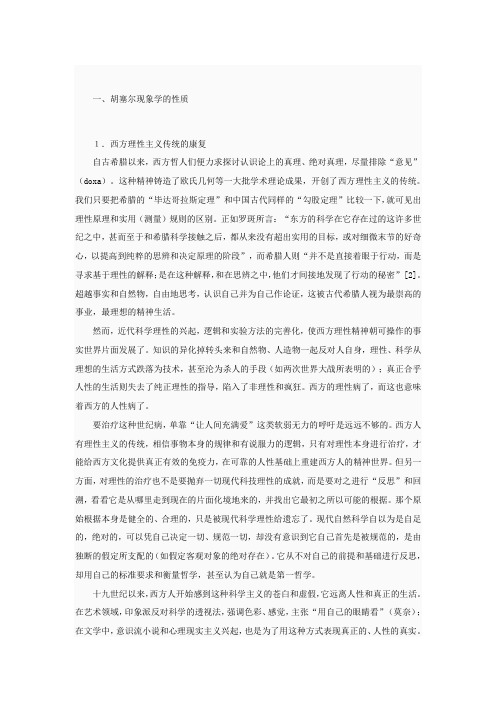
一、胡塞尔现象学的性质1.西方理性主义传统的康复自古希腊以来,西方哲人们便力求探讨认识论上的真理、绝对真理,尽量排除“意见”(doxa)。
这种精神铸造了欧氏几何等一大批学术理论成果,开创了西方理性主义的传统。
我们只要把希腊的“毕达哥拉斯定理”和中国古代同样的“勾股定理”比较一下,就可见出理性原理和实用(测量)规则的区别。
正如罗斑所言:“东方的科学在它存在过的这许多世纪之中,甚而至于和希腊科学接触之后,都从来没有超出实用的目标,或对细微末节的好奇心,以提高到纯粹的思辨和决定原理的阶段”,而希腊人则“并不是直接着眼于行动,而是寻求基于理性的解释;是在这种解释,和在思辨之中,他们才间接地发现了行动的秘密”[2]。
超越事实和自然物,自由地思考,认识自己并为自己作论证,这被古代希腊人视为最崇高的事业,最理想的精神生活。
然而,近代科学理性的兴起,逻辑和实验方法的完善化,使西方理性精神朝可操作的事实世界片面发展了。
知识的异化掉转头来和自然物、人造物一起反对人自身,理性、科学从理想的生活方式跌落为技术,甚至沦为杀人的手段(如两次世界大战所表明的);真正合乎人性的生活则失去了纯正理性的指导,陷入了非理性和疯狂。
西方的理性病了,而这也意味着西方的人性病了。
要治疗这种世纪病,单靠“让人间充满爱”这类软弱无力的呼吁是远远不够的。
西方人有理性主义的传统,相信事物本身的规律和有说服力的逻辑,只有对理性本身进行治疗,才能给西方文化提供真正有效的免疫力,在可靠的人性基础上重建西方人的精神世界。
但另一方面,对理性的治疗也不是要抛弃一切现代科技理性的成就,而是要对之进行“反思”和回溯,看看它是从哪里走到现在的片面化境地来的,并找出它最初之所以可能的根据。
那个原始根据本身是健全的、合理的,只是被现代科学理性给遗忘了。
现代自然科学自以为是自足的,绝对的,可以凭自己决定一切、规范一切,却没有意识到它自己首先是被规范的,是由独断的假定所支配的(如假定客观对象的绝对存在)。
胡塞尔现象学——朝向事情本身(严磊)

4、意义意向
LOGO
(3)认识活动 “纯粹意指的活动以一种对准意向对象的方式在直观行为中得到充实。 我们体验到,在符号活动中单纯被思考的同一个对象,在直观中被直 观的具体呈现出来。”——胡塞尔 例子: 当我们意向一棵树时,这棵树还只是纯粹的概念,随着我们对树的种 种直观,树的意义得以充实,而他也就得以显现出它的同一性来。 可见,认识实际是由表达式、意义意向、直观活动和充实这四个因素 组成的一个整体结构。 充实在这里表现为一个上升的不断完善的过程,它将单纯的意向越来 越直接的带到事情本身,这个过程最终就是认识对象的充分表现,即 思想与事物在直观中完全一致,完成了对象意义的最终充实。
3、对意识的研究
LOGO
(2)意识的定义 在《逻辑研究》的第五研究中胡塞尔提出了以下三个意识概念: A、意识是经验自我全部实质的现象学的持续存在,是交织在体验流 的统一中的心理体验; B、意识是对自己心里体验的内在觉察; C、意识是一切“心理活动”和“意向体验”的总称。 思考: A:切断意识与经验自我的联系,心理学意义上的体验就变成了现象 学意义上的体验。 B:意向性不仅仅是意识行动,也包含意识内容。 C:意向性概念将一切意识都包括在内,使得意向性研究具有了普遍 的意义。5、“明见的体验”
LOGO
“对象之物就是被意指的东西,是现实的当下的或被给予的” ——胡塞尔 胡塞尔认为真理并不是主观认识和外部事物的符合一致,他从现象学 角度重新定义了这种意识的对应模式——“明见的体验”。 “明见” 是一个事物自我给予的体验,即意指对象在直观中自我显现的体验。 (1)真理首先是对象性的,它应于明见; (2)真理是事物与思想绝对的相应的观念,属于意识活动形式; (3)也可以把意向理想的充实称为真理、真或存在; (4)真理是意向的正确性。
- 1、下载文档前请自行甄别文档内容的完整性,平台不提供额外的编辑、内容补充、找答案等附加服务。
- 2、"仅部分预览"的文档,不可在线预览部分如存在完整性等问题,可反馈申请退款(可完整预览的文档不适用该条件!)。
- 3、如文档侵犯您的权益,请联系客服反馈,我们会尽快为您处理(人工客服工作时间:9:00-18:30)。
胡塞尔现象学阅读法
胡塞尔现象学阅读法
何为现象学?
现象学,指的是一种表象的科学(JohannHeinerichLambert)。
它认为我们可以透过对表象的研究,进展到真理。
现象学处理的是我们外在感官的动静,事物向我们表现的方式(康德),现象学指那些看似独立于意识表现的表象世界如何源于意识本身(费希特)。
胡塞尔与现象学
至于启发胡塞尔使用现象学的,是物理学家马哈在1894年建议使用“一般物理现象学”,作为描述我们的物理经验,以作为一种更具一般性物理理论的基础。
描述而非解释因果关系
现象学在胡塞尔,最初被视为“描述心理学”。
后来在《逻辑研究》中,才正式定名为“现象学”。
对胡塞尔来说,哲学的核心任务在于描述,而非因果关系的解释。
无预设原则、直观、回到物自身
胡塞尔强调现象学的“无预设原则”,抛弃哲学的理论化的可能性。
重视对现象本身的仔细描述,只对“直观”中的与料有兴趣。
胡塞尔用现象学,重新思考哲学,釐清概念,从直观洞见“回到物自身”,重新检视所有的知识概念基本意义、有效性与证明,强调直观经验的优先首要性,并从此形成更广泛的理性批判。
存而不论、自然搁置、超验还原
胡塞尔对于扭曲与阻碍我们认识日常生活经验方式的意识结构
与内容检查模式,提出了强烈的质疑。
胡塞尔则提出了对自然世界“存而不论”,“自然搁置”的“超越还原”,以便将衬托出现象的中心基本性质。
放入括弧
胡塞尔把自然世界“放入括弧”里,要求我们把过去所有的一切都放在括弧里,放在一旁,不要让这些所产生的联想,影响到我们对于现象的观察,进而妄加推断。
我们必须拒绝所有原有的假设或前提,只单单接收现象所给我们呈现的东西,使先于判断的经验从而可能。
对于我们来说,过往的生活世界,无形中替我们形成了一个充满预设、想法、偏见、知识的领域。
我们所生活的生活世界,早已充满各种见解知识判断传统道德法律科学知识偏见,我们并不是直接的生活在生活世界里,从生活世界里直观并得出结果,而是生活在诸多的预设和前提下,透过建构的概念世界,建构我们所经验到的生活世界。
上帝的眼光、无所不在的角度
为了重新认识世界,我们必须拥有一种“上帝的眼光”或“无所不在的角度”,放下一切过往的预设,回到零点,以直观洞悉物自身。
预设常常成为思考问题的阻碍。
预设就是“下条件”。
当你拥有的条件越多,就越容易被条件所引导,无法看见事物的本然面貌。
因为你心里已经接受了事物可能性,是在某些条件下所呈现的状态。
然而,这已经不是事物原本的呈现状态,是遭受预设扭曲、建构过的状
态。
理论、客观、知识、预设,都是扭曲物自身呈现的东西。
虽然过往世界便是如此教导我们以如此的方式建立知识和客观。
但现象学要我们抛却这一切,回归零点,重新回到物自身。
胡塞尔认为,传统世界的主观和客观是被建构起来的虚假对立,扭曲了真实世界与我们之间的关系,进而影响我们观看认识世界的方式,
现象学关切的,是物自身对意识的呈现方式。
物自身可视为世界,或者意识所面向的客体/对象。
意识就是我们观看者,也就是主体。
现象学要认识与描述的是意是在知识成就中所扮演的角色。
现象学博大精深,在此我们仅借胡塞尔现象学的几个基本原则(虽然某种程度上来说,这些也是预设,不过这点我们也放在括弧里,存而不论),放到阅读,作为借镜使用。
其他的,通通放到括弧里,存而不论。
现象学阅读法~回到物自身/回到文本
现象学放到阅读来看,该是如何操作?让我们循着胡塞尔的回到物自身开始。
胡塞尔现象学的教导,放在阅读上来说,便是要我们在接触一篇新文章/新观点/新书时,我们要放下过往帮助我们建构起来的知识、信念、传统、权威、偏见,把自己通通归零。
单单专注在眼前这部文本(物自身)上,在“无预设的前提”下,透过经验直观,以“上帝的眼光”或“无所不在的角度”,尽可能的贴近文本,描述文本所要
传递的各种信息,不要针对过去所学所知,骤下结论,或者归纳观点,演绎概念,仅仅透过详实的描述,掌握文本的所有面貌,直观文本自身。
至于对于读不懂的或者和文本核心无关的,就当做自然世界,大可以“放入括弧、存而不论”,无须介意或讲究。
现象学阅读法,让我们以一切可能的面向,读懂所能懂得,然后对于所不能懂的,便暂时放入括弧,当作自然世界般的存在,不要想破头,也不用勉强解释,放在一边既可。
是种回到文本本身的阅读方法,尽可能的贴近文本,描摹而非解析它,你会读到很多以往带着太多理论眼镜所看不见的东西。
